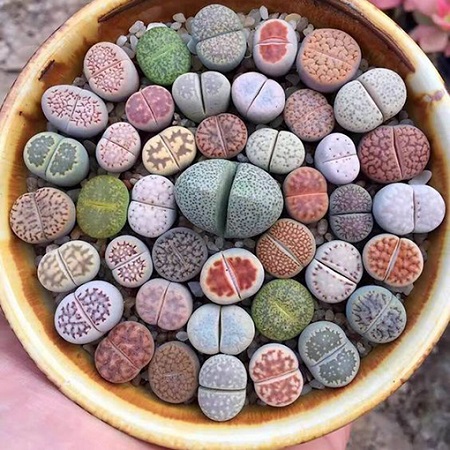
Nature has a way of surprising us with its ingenious adaptations, and Lithops, commonly known as “Living Stones,” are a prime example of this marvel. These succulent plants, native to Southern Africa, have evolved to resemble small stones, blending seamlessly into their arid surroundings. In this article, we will explore the intriguing world of Lithops and provide guidance on how to grow and care for these captivating plants in a home or greenhouse setting.
Lithops are members of the Aizoaceae family and are renowned for their unique leaf structure, which resembles stones or pebbles. This extraordinary camouflage allows them to evade detection by blending in with their rocky desert environment, protecting them from herbivores and extreme climatic conditions.
Growing and caring for Lithops can be a rewarding endeavor, but it requires attention to their specific needs. Here are some essential instructions to help you cultivate these fascinating plants:
Care Instructions
Light and Temperature
Lithops thrive in bright light conditions. Place them in a location where they can receive at least six hours of direct sunlight each day. Ensure that they are protected from intense midday sun, as it can scorch their leaves. Optimal temperatures for Lithops range from 65°F to 85°F during the growing season. However, they can withstand a wider temperature range, including cooler temperatures during their winter dormancy period.
Soil and Potting
Lithops require well-draining soil to prevent waterlogged roots. A mix specially formulated for succulents or cacti works best. Alternatively, you can create your own by combining coarse sand, perlite, and potting soil in a ratio that provides good drainage. Ensure the pot has drainage holes to avoid water accumulation.
Watering
One of the critical aspects of Lithops care is proper watering. These plants are adapted to arid conditions and have a unique growth cycle. During their active growing season, typically in the spring and fall, water the Lithops sparingly. Allow the soil to dry out almost completely between waterings. In summer, reduce watering as they enter their dormant phase, mimicking the natural dry season in their native habitat. Avoid overwatering, as it can lead to root rot and other issues.
Fertilization
Lithops have modest fertilizer requirements. During their active growing season, you can use a diluted, balanced liquid fertilizer specifically formulated for succulents. Apply the fertilizer sparingly, following the instructions on the package, to avoid overfeeding, which can be detrimental to their growth.
Dormancy Period
Lithops go through a natural dormant period during the summer, where their growth slows or stops. During this time, reduce watering significantly, allowing the soil to dry out completely before providing a small amount of water. Avoid fertilization during the dormancy period.
Repotting
Lithops have a shallow root system and generally do not require frequent repotting. However, if your Lithops outgrows its current container or if you notice signs of overcrowding, repot it into a slightly larger pot using a well-draining succulent soil mix.
Pest and Disease Control
Lithops are generally hardy plants, but they can be susceptible to pests such as mealybugs and aphids. Regularly inspect your plants for signs of infestation, and if necessary, treat them with appropriate insecticidal soap or horticultural oil. Ensure good airflow around the plants to prevent fungal diseases.
Growing Lithops can be a fascinating journey, as you witness their unique growth patterns and the emergence of their beautiful, daisy-like flowers during the growing season. With patience, attention to detail, and adherence to their specific care requirements, you can enjoy the beauty and wonder of these living stones in your own home or greenhouse.
Lithops are not only intriguing botanical specimens but also a testament to the resilience and adaptability of nature. By cultivating these remarkable plants, you can bring a touch of the arid South African desert into your own space, marveling at their ability to mimic stones while flourishing in a controlled environment.
10 Fun Facts About Lithops
Mimicry Masters
Lithops are renowned for their exceptional camouflage abilities. They have evolved to resemble small stones or pebbles, allowing them to blend seamlessly into their arid surroundings and evade detection by herbivores.
Scientific Name Meaning
The scientific name “Lithops” is derived from the Greek words “lithos,” meaning “stone,” and “ops,” meaning “like” or “resembling.” It perfectly captures their stone-like appearance.
Leaf Structures
Lithops have a unique leaf structure that consists of two fleshy, leaf-like structures called “leaves.” These structures grow together, forming a cleft or slit at the top, which serves as a growth point and allows light to reach the inner part of the plant.
Diverse Colors and Patterns
Lithops exhibit a wide range of colors and patterns, including shades of green, brown, gray, pink, and purple. These colors help them blend in with their surroundings and provide excellent camouflage.
Slow Growth
Lithops are slow-growing plants. It can take several years for a Lithops seedling to reach its full size and maturity. Their slow growth rate adds to their allure and makes them prized possessions for patient plant enthusiasts.
Flowering Beauties
During their active growing season, Lithops produce stunning daisy-like flowers. The flowers come in various colors, including yellow, white, orange, and pink. The flowers emerge from the slit at the top of the plant and add a vibrant touch to their stone-like appearance.
Underground Storage
Lithops are succulent plants, which means they can store water in their leaves. During periods of drought or extreme aridity, they draw upon these water reserves to survive.
Pollination by Flies
The flowers of Lithops emit a scent like that of rotting organic matter to attract flies, which serve as their primary pollinators. The flies are lured by the scent and are responsible for transferring pollen between the flowers.
Long Lifespan
With proper care, Lithops can have a remarkably long lifespan. Some species have been known to live for several decades, making them enduring companions for plant enthusiasts.
Cultural Significance
In their native Southern Africa, Lithops hold cultural significance. They are often used in traditional medicine and have been associated with various beliefs and rituals by local communities.
Related Articles & Free Email Newsletter Sign Up
Haworthias are Super Succulents for Small Spaces
How to Propagate Super Succulents




Comment here